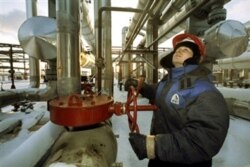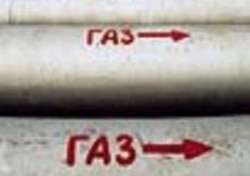According to the CIA World Factbook, in 2003 -- the last year for which Chinese gas data is available -- China consumed a mere 33.4 billion cubic meters (bcm) of natural gas. That's a fraction of what is consumed in the United States (633 bcm in 2003) or Russia (402 bcm in 2004). Gas presently constitutes only 3 percent of China's energy balance.
With China's energy needs growing, this is set to change. Beijing is already in the market to buy gas and is eager to construct the needed infrastructure to take delivery of the fuel.
The Chinese have signed a 25-year contract to buy liquefied natural gas (LNG) from Australia and plan to construct a third LNG terminal by 2009.
Russian Strategy
Anticipating rising Asian (namely, China and South Korea) demand for gas, in August 2004, an interagency task force was created by the Russian Ministry for Industry and Energy to prepare a number of scenarios for the development of the gas industry in Eastern Siberia and the Russian Far East.
The task force took into account potential sales to Asia, but its primary goal was to consider the development of the gas infrastructure in these two remote regions in order to serve Russian domestic needs.
Presently Eastern Siberia and the Russian Far East rely primarily on coal to meet their energy needs. But with an abundance of potentially cheap and environmentally cleaner gas, this is likely to change in the not-too distant future.
The task force reported that current gas reserves in the two regions are around 45 trillion cubic meters, the vast majority of which has not been tapped. Of these reserves, 70 percent are located in Eastern Siberia.
Four major gas fields are being considered as the most likely production centers: the Kovytka field in Irkutsk; the Chayadinsk field in Yakutsk; the Sobinsk-Paiginsk field in Krasnoyarsk; and the Sakhalin fields (the so-called Sakhalin-1 and 2 projects and possibly Sakhalin-3, which has been on the back burner for years). All the fields are known to contain gas, but further exploratory work is needed to determine just how accessible it is.
The analysts took into consideration the possibility that additional reserves of up to 6 trillion cubic meters could be discovered by 2030. If this should materialize, the task force estimates that annual gas production from the region could reach 150 billion cubic meters. But the costs of extracting the gas would be high -- around $7.5 billion.
Scenario 'West'
The task force presented three scenarios to the government.
The first is named "West" and is estimated to cost $37 billion, most of which would be spent in 2007-2010.
It projects that gas from Irkutsk, Krasnoyarsk, and Yakutsk will flow into one transportation system, which will deliver gas to the Unified Gas Transportation System (UGS), the all-Russian pipeline network, as well as to China and South Korea. The main field for exports to Asia is projected to be Chayadinsk in Yakutsk. According to the scenario, gas from the giant Kovytka field will not be exported to Asia in the initial stages.
Operations would begin in 2007 and, by 2010, the total gas production from Kovytka and Chayadinsk would be 10-11 bcm, 5 bcm of which would be available for export to China and South Korea. By 2030, "West" projects that production from these two fields would rise to 60 bcm per year of which 25 bcm would be for export.
Exports from Sakhalin in this scenario would be exclusively in the form of LNG.
Scenario 'Center'
The second scenario, "Center," calls for the construction of three pipelines, which would connect to the USD system for domestic consumption. This scenario precludes gas from Kovytka being exported to Asia and projects a pipeline under the Sea of Japan to supply South Korea with gas from Sakhalin. China would receive 15 bcm of gas annually from the Chayadinsk field via pipeline. The total cost of this scenario would be $36 billion, most of which would be spent in 2007-09.
Scenario 'East'
The third scenario, "East," differs from the other two in that it projects that the only gas sold to the Asian market would be from Sakhalin and would be transported by pipeline and as LNG. This in turn would necessitate the creation of the Sakhalin-3 project.
The Kovytka field would be limited to only supplying the Russian domestic market.
"East" proposes leaving the Chayadinsk field unexploited, thus removing the necessity of building a costly pipeline from Yakutsk, and saving an estimated $4 billion-$5 billion.
Decisions, Decisions
Which scenario Russia chooses depends largely on the projected domestic price for gas in Russia and how it compares with the price for coal, the main fuel used in Siberia and the Far East.
All three scenarios call for relatively small deliveries of gas to China by 2030. The largest projection, in the "West" scenario, calls for a total of 25 bcm per year to both China and South Korea.
Given that South Korea uses more gas than China, the Chinese share of 25 bcm would likely be relatively small. Such a low volume would have little impact on China's energy balance or would make China reliant on Russian gas.
On March 21, RIA Novosti reported that during his visit to China, Putin stated that Russia would sell Beijing 30-40 bcm of gas annually, although the president did not give a time frame.
This figure, however, seems somewhat exaggerated in light of the three scenarios. And given the high costs of these projects, it is doubtful what commercial interests would be served by such grandiose plans.
In February 2005, the U.S. Congressional Research Service issued a report, "Rising Energy Competition and Energy Security in Northeast Asia: Issues for U.S. Policy," which found that:
"Natural gas is an attractive long-term alternative for China in that it is plentiful outside the Middle East and relatively environmentally-friendly. In the short-term, however, the cost of gas infrastructure and the availability of inexpensive coal as a substitute will preclude extensive use of natural gas."
Considering these factors, Russian natural gas, for all practical purposes, will likely first be used to develop Siberia and the Far East and then to meet Moscow's European commitments. How much will be available for the European Union is debatable, but apparently China will do little to compete with Europe for this commodity.
China In Central Asia
 The Almaty,Kazakhstan, office of China's National Petroleum Corporation (RFE/RL)
The Almaty,Kazakhstan, office of China's National Petroleum Corporation (RFE/RL)
BEIJING ON THE RISE: The September 11, 2001, terrorist attacks against the United States prompted Washington to topple the Taliban regime in Afghanistan. At the time, many predicted the United States would gain a new foothold in Central Asia: new U.S. military bases appeared in Kyrgyzstan and Uzbekistan, U.S. foreign aid increased, and much U.S. attention was lavished on the region. Russia and China looked on warily. But the pendulum may be swinging back in Moscow’s and Beijing’s favor. China, especially, has expended great effort at winning friends in Central Asia and is becoming a force to be reckoned with....(more)
RELATED ARTICLES
Turkmenistan-China Pipeline Project Has Far-Reaching Implications
Central Asia Looks To Fuel Asia's Economic Boom
The Geopolitical Game In Central Asia
ARCHIVE
To view an archive of RFE/RL's coverage of China, click here.

SUBSCRIBE
For weekly news and analysis on all five Central Asian countries by e-mail, subscribe to "RFE/RL Central Asia Report."
















